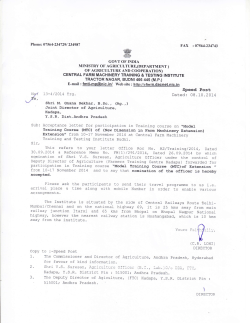
Train to Eastern Himalayas : A Sun
NORTHEAST FRONTIER RAILWAY (CONSTRUCTION ORGANISATION) PRESS RELEASE Dated : 17.02.2015 Train to Eastern Himalayas : A Sun-rise journey begins … On April 7, 2014, the sun rose at Itanagar exactly at 5:34 AM. But most people around the newly built railway station at Naharlagun, just 10 kms east of the Arunachal Pradesh capital city had woken much earlier. It was going to be a historic day – the first passenger train would chug into the beautiful state cradled in the eastern Himalayas a few hours later. And, Itanagar has also become the second state capital in the Northeast – after Guwahati – to figure in the broad gauge railway map of India. It was not just a historic moment for the Land of the Dawnlit Mountains, as Arunachal Pradesh is generally referred to. It was also a great moment for Indian Railways, as the world’s largest railway network also embraced into it the colourful people – the Adis, Nyishis, Apatanis, Galos, Mishmis, Tagins, Monpas, Sherdukpens, Tangsas, Khamtis, Singphos, Noctes, Wanchos and so on – who live in the enchanting mountains here. No doubt people flocked in large numbers to Naharlagun not just to see the first train, but also to touch and feel it, and keep that wonderful feeling in their hearts forever. Taking the railways to Arunachal Pradesh, a state that shares strategic international boundaries with three neighbouring countries – China, Bhutan and Myanmar – has been a very significant development. And, though Arunachal Pradesh had nominally found a place in the great Indian railway map earlier when a metre gauge line had reached Bhalukpong, exactly 1.26 kms inside the state about 20 years ago, connecting the state capital is what was so long most important. This was first achieved when the first test-run of an engine was successfully carried out on January 15, 2014 from Harmuti in Assam to Naharlagun, a 21.75 km railway project, work on which had begun in October 2008. Though the foundation stone of the project was laid by then prime minister Dr Manmohan Singh on January 31, 2008, actual work was delayed due to change of alignment and challenges like removing high-tension power lines and obtaining forest clearance etc. The project that connected the Arunachal Pradesh capital with a 21.75 km line from Harmuti on the Rangiya-Murkongselek section in northern Assam, has been sanctioned at a cost of Rs 407.98 crores. But that cash component apart, it also has an immeasurable investment of the love and affection of 13.48 lakh beautiful people whose music and dance, be they of the war dances or those performed during festivals and rituals, have added new rhythms to the clicketyclack of a railway train chugging in or out of Nahalagun. Though Naharlagun is located at only about 300 metres above sea level, taking the railway track up there was not as easy as it looks. Surveys and DPRs apart, the entire project involved construction of 46 minor and 11 major bridges, all across unbelievably unpredictable rivers small and big that simply run down the mountains, many a times refusing to understand what human beings are doing with nature. The Harmuti-Naharlagun section also has 14 roadsunder-bridges and of course two stations, these being Gumto and Naharlagun. People in Arunachal Pradesh in fact have been longing for a railway link for so many decades. Connectivity has remained a big dream, with the natural beauty and rich bio-diversity of the state waiting to be explored. Once known as North East Frontier Agency (NEFA), this area became a Union Territory in 1972, and finally a full-fledged state in 1987. While the first survey for a metre gauge railway line was conducted during 1996-97 in line with Indian Railway’s vision of providing railway connectivity to all state capitals of the Northeastern region, the state government’s approval for the same was received in 2006. Later on, the alignment had to be changed in 2010 on the request of the state government and finally it was taken up as a broad gauge project from Harmuti to Naharlagun (9 km in Assam + 12.75 km in Arunachal Pradesh = 21.75 km). With the government of Arunachal Pradesh giving its consent to terminate the proposed railway line at Naharlagun in March 2010, construction of the broad gauge line began immediately began. The railway line that takes off from Harmuti railway station on the RangiyaMurkongselek main line, traverses nine kms in Lakhimpur district in Assam before entering Lower Subansiri district in Arunachal Pradesh, and runs along the left bank of the Dikrong river for about six kms up to Doimukh where it crosses the river. The remaining 6.75 km is in Papum Pare district. For those interested in technical details, all bridges in this section have been built for loading standard of 25-MT and has a speed potential of 100 km per hour. For linking Naharlagun to the Indian Railways network, the railways had to also convert the old 451-km RangiyaMurkongselek metre gauge into broad guage, one line whose importance will further increase once the Bogibeel rail-cum-road bridge across the Brahmaputra is complete. Needless to say, it will also cater to the need of defense for expeditious and through movement of troops to the frontier areas. In addition, it holds the promise of bringing a lot of development and prosperity to Arunachal Pradesh by way of tourism and industrialization. Meanwhile, the gauge conversion work of the 34.47-km Balipara-Bhalukpong stretch, a branch line of the Rangiya-Murkongselek section has been also completed and a diesel locomotive has already made a successful trial run in October 2014. With this, one more district of Arunachal Pradesh – West Kameng – has found place in the great Indian Railway network. Passing through a thick forest area, it traverses only about 1.26 kms inside Arunachal Pradesh territory, but it means volumes in terms of economic activity, especially because goods will now reach the doorstep of western Arunachal at a much less cost. Future dreams : A railway line to Itanagar however is not the end of the ever-expanding great Indian railway network. The government of India has already proposed three more railway projects for the Land of the Dawnlit Mountains. While the most important and challenging one is 378-km line proposed to take off from Misamari in Assam through the rugged mountains up to Tawang via Tenga at an elevation of 3048 metres above sea level, the other two are – the 249 km North Lakhimpur-Bame(Along)Silapathar line and the 227 km Pasighat-Tezu-Rupai line. These three together promises to open up new vistas of development for the entire state of Arunachal Pradesh. The colourful communities of Arunachal Pradesh have numerous myths, legends and folk-tales woven over the centuries around their adventurous life in the high mountains. With railways finally arriving in the mountains, more such stories will soon be added. And the clickety-clack of a railway train chugging in and out will add new rhythm to the touching folk songs that keep echoing through the Eastern Himalayas. (D.C.BORAH) Sr.PRO/Con
© Copyright 2025










